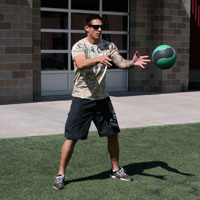by NSCA January 5, 2010

Introduction
While most fitness professionals enjoy spending time in the gym working out, often their clients do not share this same enthusiasm. Many times clients get bored or complacent when performing traditional strength and conditioning programs focused on conventional sets, reps, and steady-state activity. As a result individuals may become apathetic toward their training programs and exert less overall effort, thus reducing the physiological benefits. One way to help with this issue is by integrating competitive games into your client’s training sessions. By doing so, the primary emphasis of training shifts from simply trying to reach and maintain specific training intensities to competition and fun.
The following game is an example of a way to introduce variety into your client’s workouts.
Medicine Ball Tennis
This game is best played with 2-4 clients, but can be played one-on-one between a client and their trainer. The same basic rules of tennis apply to this game. This game can be played on a tennis court, or in a gym with a row of cones set up to simulate a net. The object is to throw the medicine ball back and forth over the net using a variety of overhead, underhand and side throws. The receiver must catch the ball before it bounces twice, and return it back over the net. If the medicine ball bounces twice before it is caught, a point is scored by the server. If the medicine ball does not bounce twice, play continues. In order to ensure safety the medicine ball must bounce once prior to being caught. Once the ball is caught the individual may take one-step, but no more, before return the ball over the net. The game is over when a set number of points are scored.
While this method offers a fun adjunct to training, the primary emphasis of a well founded health, fitness and performance program should focus on traditional and functional strength and conditioning methodologies. The 2008 Physical Activity Guidelines for Americans that suggest muscle-strengthening activities that involve all major muscle groups performed on 2 or more days per week. Traditional and functional training, in conjunction with the integration of games, will yield the best overall fitness improvements.
For more examples and information on conditioning games visit conditioning games and conditioning for field hockey.
What are some ways you integrate fun into training sessions?





